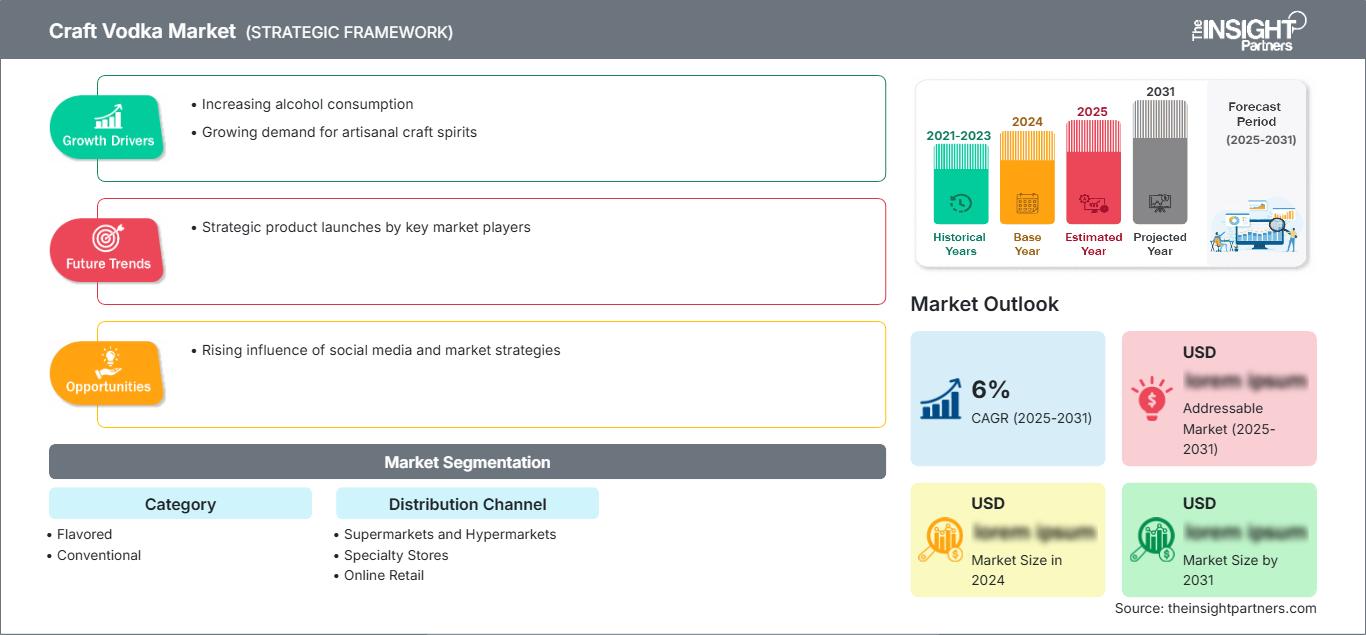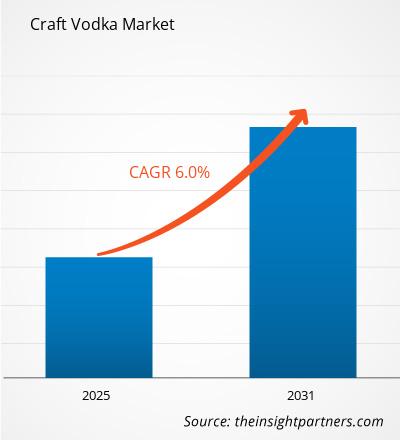Der Markt für Craft-Wodka wird zwischen 2023 und 2031 voraussichtlich eine durchschnittliche jährliche Wachstumsrate (CAGR) von 6 % verzeichnen. Der Markt für Craft-Wodka wächst aufgrund der steigenden Nachfrage nach Premium- und Craft-Produkten.
Marktanalyse für Craft-Wodka
- Der Markt für Craft-Wodka zeigt ein positives Wachstum, angetrieben durch den steigenden Alkoholkonsum, die kulturelle Wiederbelebung – Interesse an Cocktails, die in Bars und Restaurants getrunken werden, und das Bewusstsein für ihre historische Bedeutung.
- Die Verschiebung der Verbraucherpräferenzen spiegelt sich in der Wodka-Kategorie wider, da jüngere Verbraucher wie die Millennials eher bereit sind, mit Craft-Wodkas zu experimentieren, die authentischen Geschmack bieten und interessante Geschichten über ihre Herstellung erzählen.
- Der Markt für Craft-Wodka steht auch vor einigen Herausforderungen, wie z. B. starker Konkurrenz innerhalb der Spirituosenbranche, hauptsächlich durch andere Premium- und Craft-Spirituosen, begrenzten Vertriebskanälen und kürzerer Haltbarkeit sowie einem überfüllten Markt für Alkohol und Getränke.
- Die wichtigsten Marktteilnehmer konzentrieren sich auf strategische Entwicklungen wie Joint Ventures, Partnerschaften, Produkteinführungen, Innovationen und Kooperationen, um die wachsende Nachfrage der Verbraucher zu befriedigen und ihre geografische Präsenz zu erweitern.
Marktüberblick über Craft-Wodka
- Der Markt für Craft-Wodka wächst aufgrund verschiedener Treiber, darunter die Verbraucher Übergang zu hochwertigen alkoholischen Getränken.
- Das Wachstum ist auch auf das steigende verfügbare Einkommen in den Schwellenländern, d. h. im asiatisch-pazifischen Raum, zurückzuführen.
- Die zunehmende Verbreitung von Handwerksbrennereien kann als ein Faktor angesehen werden, der zum steigenden Absatz von Craft-Wodka beiträgt.
- Viele kleine Hersteller konzentrieren sich auf Qualität, Kleinserienproduktion und Innovation, was zu einer größeren Produktvielfalt und mehr Nischenmöglichkeiten führt. Mit der wachsenden Zahl handwerklicher Hersteller nimmt der Wettbewerb im Wodka-Segment zu, was zu einer stärkeren Experimentierkultur führt.
Passen Sie diesen Bericht Ihren Anforderungen an
Sie erhalten kostenlos Anpassungen an jedem Bericht, einschließlich Teilen dieses Berichts oder einer Analyse auf Länderebene, eines Excel-Datenpakets sowie tolle Angebote und Rabatte für Start-ups und Universitäten.
Craft Vodka Markt: Strategische Einblicke

- Holen Sie sich die wichtigsten Markttrends aus diesem Bericht.Dieses KOSTENLOSE Beispiel umfasst Datenanalysen, die von Markttrends bis hin zu Schätzungen und Prognosen reichen.
Sie erhalten kostenlos Anpassungen an jedem Bericht, einschließlich Teilen dieses Berichts oder einer Analyse auf Länderebene, eines Excel-Datenpakets sowie tolle Angebote und Rabatte für Start-ups und Universitäten.
Craft Vodka Markt: Strategische Einblicke

- Holen Sie sich die wichtigsten Markttrends aus diesem Bericht.Dieses KOSTENLOSE Beispiel umfasst Datenanalysen, die von Markttrends bis hin zu Schätzungen und Prognosen reichen.
Treiber und Chancen für den Markt für Craft-Wodka
Die Verbraucherpräferenzen für handwerklich hergestellte Spirituosen begünstigen den Markt
Zu den wichtigsten Treibern für das Wachstum des Craft-Wodka-Marktes zählen das erneute Interesse an historischen und handwerklich hergestellten Spirituosen, das Wachstum bei Craft-Cocktails und Mixologie, Bars und Tourismuserlebnisse mit Schwerpunkt auf Craft-Wodka, die zunehmende Bekanntheit und das Interesse von Menschen verschiedener Ethnien sowie neue Trends zu Natur- und Kräuterprodukten. Die Menschen werden anspruchsvoller, was ihre Getränke angeht, und wollen interessante Aromen und ungewöhnliche Zutaten probieren. Craft-Wodka, der typischerweise in kleinen Chargen und nach hohen Standards hergestellt wird, soll ihnen das Gefühl von Herkunft und Einzigartigkeit bieten, das den Mainstream-Marken fehlt.
Laut dem im Februar 2024 veröffentlichten Bericht des Distilled Spirits Council of The United States beliefen sich die US-Spirituosenexporte im Jahr 2023 auf insgesamt 42,2 Milliarden – ein Anstieg von 8 % gegenüber dem Vorjahr. Für amerikanische Spirituosen beliefen sich die Exporte laut Aufzeichnungen auf insgesamt 1,4 Milliarden US-Dollar, ein Anstieg von 9 % gegenüber 2022. Die wachsende Vorliebe für handwerklich hergestellte Spirituosen treibt also den globalen Markt für Craft-Wodka an.
Strategische Produkteinführungen wichtiger Marktteilnehmer
Der Markt birgt erhebliche Chancen, wie beispielsweise eine steigende Nachfrage nach aromatisiertem Craft-Wodka aufgrund der zunehmenden Vorliebe der Verbraucher für Cocktails und innovative Aromen. Dieser Markt wird von zahlreichen Produktinnovationen, wie beispielsweise aromatisierten Wodkas, dominiert, was die Erweiterung der Kundenbasis sowohl bei gesundheitsbewussten Konsumenten als auch bei geschmacklich vielfältigen Konsumentensegmenten ermöglicht. Darüber hinaus profitiert die Branche von der Erweiterung und Verbesserung des Produktportfolios in diesem relativ neuen Marktsegment. Die kontinuierliche Entwicklung und Einführung neuer Geschmacksrichtungen und Rezepturen kann die Kundennachfrage effektiv bedienen und in Experimente münden, was das Marktwachstum fördert. Die steigende Nachfrage der Verbraucher nach innovativen Produkten bietet Herstellern die Möglichkeit, Craft-Wodka auf den Markt zu bringen.
Marktsegmentierungsanalyse für Craft-Wodka
Schlüsselsegmente, die zur Ableitung der Marktanalyse für Craft-Wodka beigetragen haben, sind Kategorie und Vertriebskanal.
- Basierend auf der Kategorie ist der Markt für Craft-Wodka in aromatisierte und konventionelle Sorten unterteilt.
- Auf der Grundlage des Vertriebskanals ist der Markt in Supermärkte und Hypermärkte, Fachgeschäfte, Online-Einzelhandel und andere unterteilt.
Marktanteilsanalyse für Craft-Wodka nach Geografie
- Der Marktbericht für Craft-Wodka umfasst eine detaillierte Analyse von fünf großen geografischen Regionen, einschließlich der aktuellen und historischen Marktgröße und Prognosen für 2021 bis 2031, die Nordamerika, Europa, den asiatisch-pazifischen Raum, den Nahen Osten und Afrika sowie Süd- und Mittelamerika.
- Jede Region ist weiter in entsprechende Länder unterteilt. Dieser Bericht bietet Analysen und Prognosen für mehr als 18 Länder und deckt die Marktdynamik von Craft-Wodka ab, wie z. B. Treiber, Trends und Chancen, die die Märkte auf regionaler Ebene beeinflussen.
- Darüber hinaus umfasst der Bericht Porters Fünf-Kräfte-Analyse, die die Untersuchung der wichtigsten Faktoren umfasst, die den Craft-Wodka-Markt in diesen Regionen beeinflussen.
Craft-Wodka-Markt
Die Analysten von The Insight Partners haben die regionalen Trends und Faktoren, die den Craft-Vodka-Markt im Prognosezeitraum beeinflussen, ausführlich erläutert. In diesem Abschnitt werden auch die Marktsegmente und die geografische Lage in Nordamerika, Europa, dem asiatisch-pazifischen Raum, dem Nahen Osten und Afrika sowie Süd- und Mittelamerika erörtert.Umfang des Marktberichts für Craft-Wodka
| Berichtsattribut | Einzelheiten |
|---|---|
| Marktgröße in 2024 | US$ XX million |
| Marktgröße nach 2031 | US$ XX Million |
| Globale CAGR (2025 - 2031) | 6% |
| Historische Daten | 2021-2023 |
| Prognosezeitraum | 2025-2031 |
| Abgedeckte Segmente |
By Kategorie
|
| Abgedeckte Regionen und Länder | Nordamerika
|
| Marktführer und wichtige Unternehmensprofile |
|
Dichte der Marktteilnehmer für Craft-Wodka: Verständnis ihrer Auswirkungen auf die Geschäftsdynamik
Der Markt für Craft-Wodka wächst rasant. Die steigende Nachfrage der Endverbraucher ist auf Faktoren wie veränderte Verbraucherpräferenzen, technologische Fortschritte und ein stärkeres Bewusstsein für die Produktvorteile zurückzuführen. Mit der steigenden Nachfrage erweitern Unternehmen ihr Angebot, entwickeln Innovationen, um den Bedürfnissen der Verbraucher gerecht zu werden, und nutzen neue Trends, was das Marktwachstum weiter ankurbelt.

- Holen Sie sich die Craft Vodka Markt Übersicht der wichtigsten Akteure
Neuigkeiten und aktuelle Entwicklungen auf dem Craft-Vodka-Markt
Der Craft-Vodka-Markt wird durch die Erhebung qualitativer und quantitativer Daten aus Primär- und Sekundärforschung bewertet, die wichtige Unternehmenspublikationen, Verbandsdaten und Datenbanken einbeziehen. Einige der Entwicklungen auf dem Craft-Vodka-Markt sind unten aufgeführt:
- Bicester Sky Wave Distillery hat einen brandneuen Wodka auf den Markt gebracht. (Bicester Sky Wave Distillery/Pressemitteilung/Juni 2024)
- Newport Craft Distilling hat KEEL Vodka übernommen und erweitert damit sein Spirituosenangebot. (Quelle: Newport Craft Distilling/Pressemitteilung/Juni 2024)
Bericht zum Markt für Craft-Wodka: Abdeckung und Ergebnisse
Der „Marktbericht zu Größe und Prognose des Craft-Wodka-Marktes (2021 – 2031)“ bietet eine detaillierte Analyse des Marktes, die die folgenden Bereiche abdeckt:
- Marktgröße und Prognose für Craft-Wodka auf globaler, regionaler und Länderebene für alle abgedeckten wichtigen Marktsegmente
- Markttrends und Marktdynamiken für Craft-Wodka wie Treiber, Einschränkungen und wichtige Chancen
- Detaillierte Porter’s Five Forces-Analyse und SWOT-Analyse
- Marktanalyse für Craft-Wodka mit wichtigen Markttrends, globalen und regionalen Rahmenbedingungen, wichtigen Akteuren, Vorschriften und aktuellen Marktentwicklungen
- Branchenlandschaft und Wettbewerbsanalyse mit Marktkonzentration, Heatmap-Analyse, prominenten Akteuren und aktuellen Entwicklungen für den Craft-Wodka-Markt
- Detaillierte Unternehmensprofile
- Historische Analyse (2 Jahre), Basisjahr, Prognose (7 Jahre) mit CAGR
- PEST- und SWOT-Analyse
- Marktgröße Wert/Volumen – Global, Regional, Land
- Branchen- und Wettbewerbslandschaft
- Excel-Datensatz
Aktuelle Berichte
Erfahrungsberichte
Grund zum Kauf
- Fundierte Entscheidungsfindung
- Marktdynamik verstehen
- Wettbewerbsanalyse
- Kundeneinblicke
- Marktprognosen
- Risikominimierung
- Strategische Planung
- Investitionsbegründung
- Identifizierung neuer Märkte
- Verbesserung von Marketingstrategien
- Steigerung der Betriebseffizienz
- Anpassung an regulatorische Trends




















 Kostenlose Probe anfordern für - Craft Vodka Markt
Kostenlose Probe anfordern für - Craft Vodka Markt